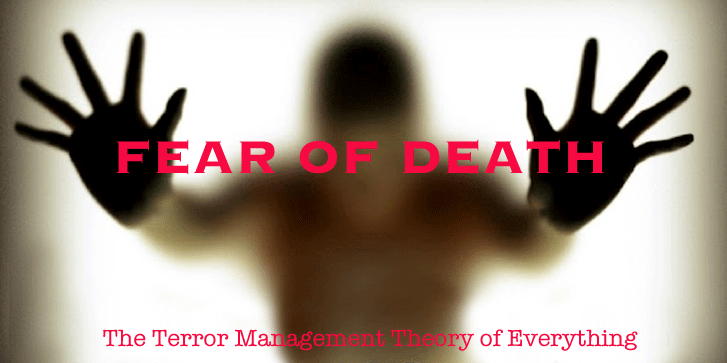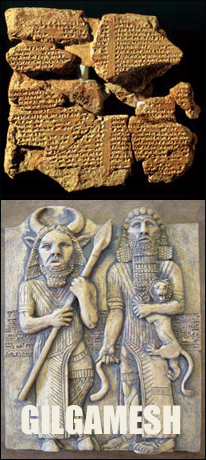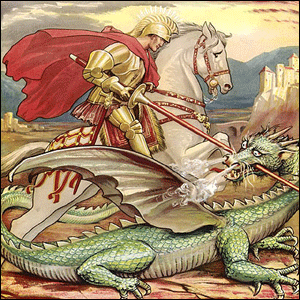

WARNING!
Scientific experiments have proven that if you read the following story, you will likely be changed. Your ideas about religion, politics -- yes, even your appreciation of art and beauty will be changed... at least temporarily. So if you like the way you feel about life right now, maybe you should skip this article.
I'm going to tell you something that you already know. It's something obvious. But it's also so horrific and terrible that it must quickly be forgotten or it could literally drive you insane. Just the reminder of this fact will be enough to change your behavior, your outlook on the world and the look on your face [1].
"The all encompassing blackness..." --William James 1910
 I'm going to describe the cutting-edge of psychological theories, called Terror Management Theory or TMT. It's been known for a while but has been kept off the radar by the media. And that's partially because TMT has been used against us (you will see how). It's a theory that explains human behavior and its most basic psychological motivator.
I'm going to describe the cutting-edge of psychological theories, called Terror Management Theory or TMT. It's been known for a while but has been kept off the radar by the media. And that's partially because TMT has been used against us (you will see how). It's a theory that explains human behavior and its most basic psychological motivator.
"In the day that you eat from it you shall surely die."--Genesis 2:17
Are YOU afraid to die?
Terror Management Theory (TMT) states that all human behavior is motivated by the fear of our own mortality. The fact that you and I will eventually die and be "no more" is a fact known and understood only by humans. Although animals have an avoidance of death, they live in the present. They don't comprehend their destiny. Only humans have the capacity to project reality in time and imagine the future. Only humans realize the significance of being "no more".
The theory originated with anthropologist Ernest Becker's 1973 Pulitzer Prize-winning work of nonfiction, The Denial of Death, in which Becker argues:
All human action is taken to ignore or avoid the anxiety generated by the inevitability of death.
The terror associated with our unstoppable annihilation creates a subconscious conflict or anxiety called cognitive dissonance. We try to cope with having to accept two contrary ideas. On one hand, we want to become involved with life and think of ourselves as a meaningful part of the world. On the other hand, what does anything matter anyway if we ultimately become "no more" -- if all this wonderment of life is temporary?
If this is all temporary, what does it matter?
According to Becker, people spend their entire lives trying to make sense of these conflicting thoughts. We are so afraid of death that we create alternate realities -- realities where we won't "cease to be". We take comfort in the fact that others share this alternate reality.
Often symbols are used to reinforce our confidence in what psychologists call our worldview.
Reminders of death: Mortality Salience
Psychologists speak of an event which stimulates awareness of our own death as mortality salience. Scientists are often curious how these reminders of death can change our thinking and behavior. They have done many experiments on this.
Mortality salience is usually achieved in experiments by inserting questions about such things as the subjects death plans (last Will & Testament or Life Insurance beneficiaries) or how old his grandfather was when he died. Half of the experimental subjects get the mortality salience and half get benign questions, then they measure the difference. Other times they flash the word DEATH at one twenty-forth of a second on a screen -- so fast that the subjects cannot see it even when they're told it is there. Yet, somehow it works. Their behavior changes.
The basis of human culture!
TMT psychologists view human culture as a belief system constructed to explain and give meaning to life and resist confronting the horror of death. One of the requirements of a successful culture is to substitute the reality of existential death with an achievable afterlife (i.e. belief in heaven or reincarnation). If not literally, then symbolically. Cemetery stones and burial monuments are examples of this. Cultures also reward enduring accomplishments to civilization with material awards, namesakes and inclusions in human history (Like naming a building or street after someone).
The worldview is the foundation of all human culture. History records that various symbols [above] that have been used to represent different worldviews. Each one offers its unique explanation of how we can coexist with death and attempts to lower our death anxiety.
The following research will show that when your worldview is threatened by another worldview, you will be so anxious that you will fight to defend your own belief system -- in fact, this is the basis of religious and political wars. It doesn't matter what you think consciously either. It's such a primal reaction that it happens anyway.
TMT Is Being Used Against Us!
When the idea was first introduced to psychology, a plethora of research was conducted with the idea of "Tell me it ain't so!" But multiple experiments have shown that TMT is able to predict and explain most of the behavior we both promote and experience.
TMT theorists believe that an individual will be so freaked out by being reminded of his death, or mortality salience, that he will invest even more belief in his worldview and resist or violently attack anything perceived as a threat to his worldview. So how did they test this?
Two famous experiments illustrate this phenomenon.
In this first study, a group of judges were asked to participate in answering a questionaire. The judges were divided into two groups. Each group was given more questions to answer but one group had subtle reminders of death contained in the questions. Both groups were then asked to review the case history of a hypothetical prostitute and to suggest a bail bond amount in dollars. Not surprisingly, the group who had received the mortality salience came down harshly on the "deviate", assigning an average bond of $455, while the control group averaged only $50.
But, it was argued, bad news of any kind could produce the same effect if it got the judge in a bad mood. Experimenters responded that the subjects did not report feeling any negative reaction, but they did more experiments anyway.
This time they reminded one group of their death and the other group received exposure to some other worrisome concern about the future. The same results were achieved with the mortality salience as before. The group that was reminded of death charged more for bond than the group who received other worrisome ideas [9]. The interesting fact was that the group who received the worrisome ideas reported feeling negative -- not the group who were reminded of their death. [2] Thus, consistent with Terror Management Theory, mortality salience effects seem to result exclusively from thoughts of death.
TMT interprets these results as the need for an individual to invest more faith and belief in their worldview when they are reminded of their mortality. Individuals will need to become more cohesive with their groups, such as religious or political affiliations.
Imagine, you can be made to be conservative and conform to the status quo by being exposed to the fear of dying. Is this a good thing?
Hot Sauce
In this study, the experimenters induced participants to write about either their own death (suggesting mortality salience) or a control topic, presented them with a target who either disparaged their political views or did not, and gave them the opportunity to choose the amount of hot sauce the target would have to consume. As predicted by TMT, participants who were reminded of their death allocated a particularly large amount of hot sauce to their worldview-threatening target.
In additional studies, the authors found that following MS induction, if the subjects were given the opportunity to verbally express a negative attitude toward the critical target, their allocation of hot sauce decreased. These results showed that if the subjects could express their negative attitudes verbally towards their politically opposite targets, they were less likely to give them extra hot sauce (i.e. reduced aggression). This suggests that verbal degredation and acts of aggression are two alternative modes of responding to MS. [11]
This would happen because the incumbent president represented the status quo -- the worldview as we knew it. Kerry was a threat to this.
In late September 2004, after receiving either a death reminder or a neutral suggestion, registered voters were asked which candidate they intended to vote for. In accord with predictions, Senator John Kerry received substantially more votes than George Bush in the control condition, but Bush was favored over Kerry following a reminder of death, suggesting that President Bush's re-election may have been facilitated by unconscious concerns about mortality in the aftermath of September 11, 2001, the anthrax attacks (which originated from a government lab) and the constant manipulation of security threat levels attributed to vaguely described "chatter" among ill-defined "enemies" of America.[3]
Are similar fears being used to control us today? While the Iraq and Afghanistan wars are winding down, threats of WWIII with Iran and Israel are keeping the mortality salience going at full speed. According to the TMT theory, this should benefit Obama's re-election, since he represents the status quo.
Death Anxiety Fuels Conservative Ideas
Increased prejudice toward worldview violators has been measured in a number of experiments assessing TMT. Following death reminders, anti-gay discrimination and affective prejudice toward gay men increased significantly. This is, according to the study, because being homosexual is not perceived as part of the standard world view. Deviation is a threat to the system that helps repress the knowledge of our certain death.[7]
In studies where men were exposed to a mortality salient event, they preferred a more earthy, domestic and ordinary looking woman over a sexy and seductive one. [6]
Terror management research has shown that after reminders of mortality, people show greater investment in and support for groups to which they belong.
In one study, subjects were presented two images of persons talking about their own race with pride. One was black and one was white. The White person expressing pride in his race was viewed by White participants as particularly racist relative to a Black person who gave a similar presentation. However, after White participants were reminded of their own mortality, they viewed the White presentation as less racist.[5] Even though the subjects were of different ancestral nationality, their identification with their own race was amplified by their reminder of their own inevitable death.
In my college years when the Vietnam war was raging, we used to all read and collect Playboy magazine. We were young and so mostly we didn't pay much attention to the ads -- that is until someone pointed out that all the liquor ads seemed to have subliminal messages in them. Our favorite hobby, well maybe not our favorite, was looking for hidden images in the ice cubes.
Normally, ice cubes have a montage of shadows, reflections and odd shapes. While we found occasional nude women in some of them, most seemed to portray images more suitable for Halloween. Skulls, skeletons and faces screaming in agony were the most common motifs.
For years I wondered why advertisers would put such horrific images in liquor ads. How could this possibly sell whiskey or bourbon?
TMT was obviously known to these ad men. Most addictions are diversions from the real horror -- the reality of our eventual demise. It seems plausible that by causing readers to experience mortality salience their death anxiety would increase to the point where... where... where did I put that drink?
It's all about self-esteem
As I hinted earlier, our appreciation of beauty has two tiers. First, we are hard-wired to be attracted to sexual partners by evolution. We can accurately determine good genes and fertility by our concept of what makes a beautiful person (i.e. symmetry of facial features, good proportions, etc.). But our appreciation of other forms of beauty seems to have origin in our preference for pattern, repetition, organization and symbolism. These are phenomenon in our environment associated with replication and growth -- signs of life. This appreciation of beauty -- esthetics -- results from our avoidance of entropy -- the breakdown of order which is characteristic of our own death.
Julian Jaynes, in his acclaimed work, The Origin of Consciousness in the Breakdown of the Bicameral Mind, showed that much of what we think and do is devoid of consciousness. He gives strong examples of how we can drive a car while thinking about another time and place; talk and write without awareness of the complex process going on to produce the vocabulary. Even learning does not require consciousness -- the phenomenon of self-awareness [12]. Or, "Being conscious of the fact that you are conscious." In fact, our recognition and reaction to mortality salience is without our conscious involvement.
But something feels the "ouch!" when we get a sub-conscious reminder that we are mortal.
In Jaynes' book, he credits the development of language as the prerequisite for the "inner dialog" that creates our awareness of the "I" and "Me". Language is made from metaphores. Each new concept or word is "sort of like" some other word. That's how dictionaries function. So in order to have a concept for selfhood, a previously understood "it's sort of like..." had to be available. We needed language before we could develop consciousness and selfhood. The concept of "self" is therefore not that old. Jaynes suggests it has its origins about 3000 BCE.
The Epic of Gilgamesh is among the earliest known works of literature. Scholars believe that it originated as a series of Sumerian legends and poems and was written just about five hundred years shy of Jaynes' assertions. Even more telling is what the epic is all about.
The protagonist of the story, Gilgamesh king of Uruk, has a close friend who shares adventures with him and unexpectedly dies. Gilgamesh becomes depressed and embarks on a journey to find "eternal life" -- the solution to death.
Death anxiety targets our self-esteem. It motivates us to keep busy and attempt to seek "eternal life" symbolically through our actions. An experiment which confirmed this was conducted as follows:
Death and Self-Esteem: The Experiment
The subjects were 603 soldiers who first reported on the relevance of automobile driving to their self-esteem. Then half of them were exposed to various reminders of death, and the remaining to a control condition.
Experimenters then tested each group in a driving simulator to assess their risk taking. The measures were either self-reported behavioral intentions of risky driving or driving speed in a car simulator. As expected, the subjects who linked their self-esteem to driving and also received death reminders took more risks in their driving than the control group. But what was happening here?
Another experiment had half of the participants in each condition receiving positive feedback about their quality of driving. Presumably this would bolster their self-esteem. Findings showed that being reminded of death led to more risky driving than the control condition -- but only among individuals who perceived driving as relevant to their self-esteem. Even more significant, the introduction of positive feedback elevated self-esteem and eliminated this effect.[4]
And besides self-esteem, mortality salience has one more conscious manifestation: evil.
Evil (Death) & The Hero
If we are conscious of ourselves, we are conscious of all that we will have to "give up" upon our death. There is tremendous anxiety over this and some of it is relieved in symbolic conquests where the real demon is substituted with lesser foes.
Terror Management Theory is really the theory of human culture and our many attempts to be conscious about "something else" -- anything but our death. That "something else" is often associated with maintaining our self-esteem. Our self-esteem improves when we receive confirmation from other people that we are meaningful and relevant in life. This counteracts the powerful anxiety that comes from our absolute surety that we will someday die and our "self" will not exist. So organizations, political parties and religions have developed to fill our need. Each offers a means to symbolically avoid non-existence.
St. George's defeat of the dragon [right] is a strong symbol for the fight against death.
The town had a pond, as large as a lake, where a plague-bearing dragon dwelled that envenomed all the countryside. To appease the dragon, the people of Silene used to feed it two sheep every day, and when the sheep failed, they fed it their children, chosen by lottery. It happened that the lot fell on the king's daughter, who is in some versions of the story called Sabra.[8] The king, distraught with grief, told the people they could have all his gold and silver and half of his kingdom if his daughter were spared; the people refused. The daughter was sent out to the lake, decked out as a bride, to be fed to the dragon.
Saint George by chance rode past the lake. The princess, trembling, sought to send him away, but George vowed to remain. The dragon reared out of the lake while they were conversing. Saint George fortified himself with the Sign of the Cross, charged it on horseback with his lance and gave it a grievous wound. Then he called to the princess to throw him her girdle, and he put it around the dragon's neck. When she did so, the dragon followed the girl like a meek beast on a leash. [14]
Live it... or live with it
The lesson of St. George and the Dragon is that we may not be able to defeat death, but we can tame it. We can make the most of our life and forget about the inevitable. Death can become a quiet and subdued creature that follows after us like a pet. Rather than triumph over death, we can learn to coexist with it.
To recapitulate: Consciousness, the concept of "I" and "me", evolved only recently as a result of our development of language. With consciousness came the discovery that this "self" was mortal and would someday be "no more."
The most basic motivator of human culture is to create alternate realities in which we can achieve victory over the anxiety of our recognition of eventual death. This death anxiety is repressed in normal consciousness but is fully "awake" subconsciously. It influences our behavior and thoughts, makes us appreciate order and affirm life. It creates our worldview, which we share with other humans. Different worldviews sometimes conflict, resulting in wars and aggression.
When we are consciously reminded of our mortality, we invest more belief in our own worldview. We attempt to have victory over our environment, our bodies and even our instincts as a means to separate ourselves from the natural, animalistic creatures in the hope that we are something more permanent and worthy of immortality. This drive to symbolically overcome death is the primary driver of human culture and influences what we like and dislike, what is beautiful and ugly, and what is good and evil.
[2] Greenberg, J., Simon, L., Harmon-Jones, E., Solomon, S., Pyszczynski, T. and Lyon, D. (1995), "Testing alternative explanations for mortality salience effects: Terror management, value accessibility, or worrisome thoughts?" European Journal of Social Psychology, 25: 417-433.
[3] "Age-related differences in responses to thoughts of one's own death: Mortality salience and judgments of moral transgressions", Maxfield, Molly; Pyszczynski, Tom; Kluck, Benjamin; Cox, Cathy R.; Greenberg, Jeff; Solomon, Sheldon; Weise, David, Psychology and Aging, Vol 22(2), Jun 2007, 341-353.
[4] The impact of mortality salience on reckless driving: A test of terror management mechanisms.
Ben-Ari, Orit Taubman; Florian, Victor; Mikulincer, Mario
Journal of Personality and Social Psychology, Vol 76(1), Jan 1999, 35-45.
[5] "The siren's call: Terror management and the threat of men's sexual attraction to women",
Landau, Mark J.; Goldenberg, Jamie L.; Greenberg, Jeff; Gillath, Omri; Solomon, Sheldon; Cox, Cathy; Martens, Andy; Pyszczynski, Tom, Journal of Personality and Social Psychology, Vol 90(1), Jan 2006, 129-146.
[6] Sympathy for the Devil: Evidence that Reminding Whites of their Mortality Promotes More Favorable Reactions to White Racists, Jeff Greenberg, Jeff Schimel, AndyMartens, Sheldon Solomon and Tom Pyszcnyski, Motivation and Eotion, Vol. 25, No. 2, 2001
[7] Russell J. Webstera; Donald A. Sauciera, "The Effects of Death Reminders on Sex Differences in Prejudice Toward Gay Men and Lesbians", Journal of Homosexuality, Volume 58, Issue 3, 2011, Pages 402-426
[8] Greenberg, Pyszczynski, Solomon, Rosenblatt, Veeder, Kirkland and Lyon 1990; Greenberg, Simon, Pyszczynski, Solomon and Chatel 1992; Rosenblatt, Greenberg, Solomon, Pyszczynski and Lyon 1989
[9] European Journal of Social Psychology Volume 25, Issue 4, pages 417-433, July/August 1995
[10] Joel D. Lieberman, Sheldon Solomon, Jeff Greenberg, Holly A. McGregor,
"Advertising Opportunities with Wiley Online Library -- A hot new way to measure aggression: Hot sauce allocation", Aggressive Behavior, Volume 25, Issue 5, pages 331-348, 1999
[11] McGregor, Holly A.; Lieberman, Joel D.; Greenberg, Jeff; Solomon, Sheldon; Arndt, Jamie; Simon, Linda; Pyszczynski, "Terror management and aggression: Evidence that mortality salience motivates aggression against worldview-threatening others," Journal of Personality and Social Psychology, Vol 74(3), Mar 1998, 590-605.
[12] Jaynes, Julian, "The Origin of Consciousness in the Breakdown of the Bicameral Mind" (1976), ISBN 0-395-20729-0
[13] http://en.wikipedia.org/wiki/Epic_of_Gilgamesh
[14] http://en.wikipedia.org/wiki/Saint_George_and_the_Dragon
COMMENTS:
I have to say that I really appreciated your article on the viewzone. I had read a little about TMT in regards to its origins and it's affects on human culture. Your article was very insightful and it definitely makes me think of myself and my surroundings differently. I really needed it as most people do. Thank you!
Henoch S.
"Time and ego are persistent illusions." Albert Einstein
After reading this article, I was reminded of the work of Alfred Korzybski, who like Einstein, was also a student of Minkowski. Korzybski pioneered the science of neuro-linguistics and the concept of time-binding. In essence, language structures neural pathways during early development and the dualistic nature of language contributes to a world view that is itself a limited abstraction of reality based upon opposing principles.
The fear of death is essentially the fear of losing one's ego. This is one of the characteristics that are overcome by those who have had a "near death experience". The real goal of most spiritual disciplines is to sublimate or conquer the illusion of ego. This concept pervades most of the world's mythologies as exampled by the reference to St. George and the dragon.
The fear of death and the illusion of ego are driving concepts that have formed all of the worlds established cultures. As the ego becomes aware it defines itself by the cultural context in which it develops and this is what fuels the desire to associate in groups with common ideologies.
John P. Walliser
I think that as human beings on this planet that we live in we tend not to think about the bigger picture and we always compartmentalize everything. We tend to only study and teach things we are more comfortable with that we can easily expalin that is not outside our box. When we get to an age that we know our existence on this planet will be no more most of us all of sudden become spiritual and seem to have a connection to a spiritual self. Wether it be with god or some other form or sense of being. Yet most of us question if there is life after death and if we are just finished and that's it. Do we die and get buried and that's it no more or is there something else more powerful than all of us. Some connection to another dimension or spiritual reality somewhere else.
I think there should be more research and more scientific work to be done on possible life after death and any connections to another dimension we know nothing about. I am saying this as I have a personal story concerning my mother. She had died when I was eleven years old. She killed herself by taking an overdose of tranqulizers that our family doctor prescribed to her. My fathers boss had stopped in to see if my dad was at home and noticed my mother laying on the floor. He called an ambulance and was rushed to the hospital. The doctors and nurses had her hooked up to the life support systems and heart monitor and were not able to get any pulse or brain activity they had given her the electric shocks to get her heart beat back with no avail nothing worked. They had placed the sheet over her body and came to see my dad and told him she was clinically dead. The priest came and asked if she was catholic and would give her the last rights. He entered her room and began giving them but did not realize she was still hooked up to the monitors. The machine came back to life and started to blip and showed a heart beat. He told the doctros who rushed back in and brought her back to life. As they checked her and asked her questions she seemed to have no brain damage or effects from the entire time she was transported to the hospital whicj took roughly 30 minutes and the time of her death which I was told until later in life was for about five to ten minutes. She remained in the hospital for a few days and was omitted in the psychiatric part of the hospital for counselling for depression.
My mother was released after a week and came back home and continued to get counseling for a period of three or four months for her depression and things worked out for her and she was able to manage it in a much better way. It was not until I turned about twenty years old she confided in me about something very personal. She told me she could remember everything about her death and that she remembers taking the pills and falling asleep. She remembers my dads boss looking over her the ambulance attendants checking her and picking her up and taking her into the ambulance. Here is the weird part she actually tells me she is watching them all do this from above she is looking down at them and she is watching it all. Now I kind of thought this was a joke or you know maybe the medication she was on or something or possibly some kind of connection to these people when they were dealing with her. Yet this get's better she tells me she can remember the hospital and the doctors working on her and she can remember the moment she died and she felt this tremendous warmth rush over her and could seea light appear in the distance and it was like a tunnel and it was calling her somehow telling her to go into it to follow the light. She told me she felt the most incredible feeling of happiness and love and started to go to the light she was going towrds it through this tunnel and all of a sudden there were four beings at the end of the light and they stopped her. They told her that it was not time for her to leave and she needed to complete three more things here before she could be accepted. She told me that she did not want to leave and she pleaded with them to stay and continue because she felt so wonderful and wanted to stay. They continued to instruct her to remain as she had to complete the three things on Earth before they could accept her and she would know in time what these three things were. All of a sudden she awoke and noticed the docotrs checking her and asking her some questions.
It was pretty freaky that she could remember all this and see everyhting that was happenning. Now I was not sure what to think of this and I told my mother I heard that some scientists and doctors had worked on this kind of thing and said that the light that people see is just the last few electric impulses our brains have before we die. My mother insisted that this is not so that she really experienced a spiritual meeting and conversed mentally with beings and saw everyhing in a different way. She told me that she now has no fear of death and if she were to die she would be completely happy and know there is another life after death.
Now I have heard other people having the same experiences and our family ancestry is native we are Algonquins and Ojibwe by blood. In the native cultures you hear the elders and other native people speak of spirits who talk to them or send them messages of how there life path or journeys' should be. They have out of body experiences. They make important decisions based on what they should be doing in life before they can meet with their ancestors in the other world. I also have read stories from the bible where Moses and other deciples are spoke to by god and spirits would visit him in his dreams and give him orders to or make decisions for him to help his people. Now how is this possible and how does the brain work? There is more to this than we can explain. How people have lived passed lives and can remember details no one else knows. Parasychologists,scientists, doctors, archealogists etc. do not like to talk about the things they cannot answer or have definite answers. They all love to be in there comfort zones and stay there. They can only answer what they know and will not progress beyond that. We need to have more of these professional think out of the box and research these ideas more. They need to be more cognizant of spiritual selves and maybe find a connection with our minds or brains that maybe is used as a kind of communication device with other beings or spirits. After all there are more questions to be answered in life we have no idea or answers for. We all live in a Univers billions and billions of years old that is full of other galaxies and universes how do we know that in some way we are not all connected together on some type of higher plane? I tend to believe my mother and I think when it is time for me to die I would like to be happy knowing that there is something more to my being than just living on Earth and dying never to be heard of again?
RB

The Judges & the Prostitute 
 Laboratory experiments investigating aggressive behavior pose a problem. If the aggression is directed towards a real person there is the risk of someone being hurt or injured. Psychologists have invented numerous means of assessing aggression in indirect ways. A group of experimenters recently developed a new method for measuring aggression, specifically, the amount of hot sauce administered to a target known to dislike spicy foods [10].
Laboratory experiments investigating aggressive behavior pose a problem. If the aggression is directed towards a real person there is the risk of someone being hurt or injured. Psychologists have invented numerous means of assessing aggression in indirect ways. A group of experimenters recently developed a new method for measuring aggression, specifically, the amount of hot sauce administered to a target known to dislike spicy foods [10]. Back in 2004, an experiment was conducted to assess the effect of a subtle reminder of death on voting intentions for the 2004 U.S. presidential election. On the basis of Terror Management Theory it was hypothesized that a mortality salience suggestion would increase support for President George W. Bush (the incumbent) and decrease support for Senator John Kerry (the challenger).
Back in 2004, an experiment was conducted to assess the effect of a subtle reminder of death on voting intentions for the 2004 U.S. presidential election. On the basis of Terror Management Theory it was hypothesized that a mortality salience suggestion would increase support for President George W. Bush (the incumbent) and decrease support for Senator John Kerry (the challenger).
 Skulls and Bones in the Whiskey
Skulls and Bones in the Whiskey While it is true that there are earlier texts showing language in cuneiform, these are mere ledgers, records of land boundaries and crop tallies. There is no hint of self awareness until The Epic of Gilgamesh.
While it is true that there are earlier texts showing language in cuneiform, these are mere ledgers, records of land boundaries and crop tallies. There is no hint of self awareness until The Epic of Gilgamesh.Ultimately the poignant words addressed to Gilgamesh in the midst of his quest foreshadow the end result: "The life that you are seeking you will never find. When the gods created man they allotted to him death, but life they retained in their own keeping." -- [13]
 Some of this anxiety can be exhorcize in sports or games but more often the demons are symbols of a threat to our personal and collective self-esteem. A threat to a group that reduces our death anxiety is a real threat. I suspect this motivated the cruelty of Roman gladiators, the deadly ball games of the Mayans and the demonization of Hitler and binLaden. We need enemies to reduce our own death anxiety.
Some of this anxiety can be exhorcize in sports or games but more often the demons are symbols of a threat to our personal and collective self-esteem. A threat to a group that reduces our death anxiety is a real threat. I suspect this motivated the cruelty of Roman gladiators, the deadly ball games of the Mayans and the demonization of Hitler and binLaden. We need enemies to reduce our own death anxiety.
[1] "Traces of Terror: Subliminal Death Primes and Facial Electromyographic Indices of Affect", Jamie Arndt, John J. B. Allen and Jeff Greenberg, Motivation and Emotion, 2001, Volume 25, Number 3, Pages 253-277